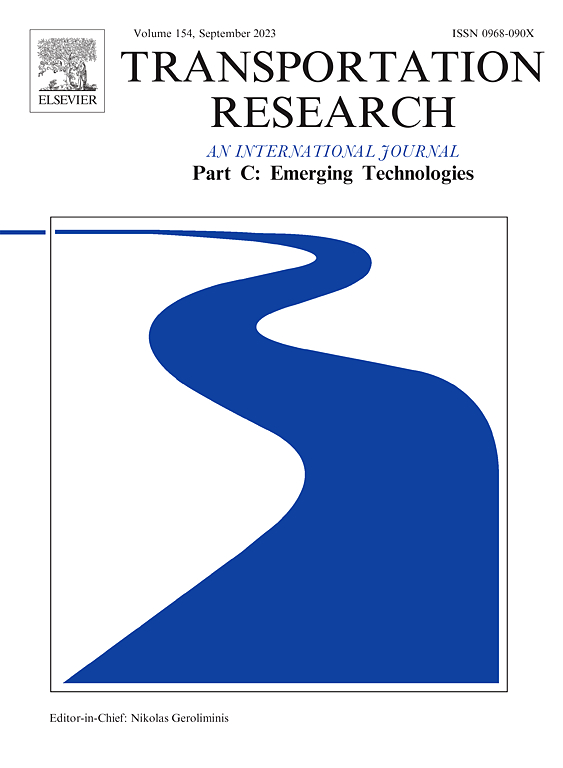Characterization of traffic dynamics in non-equilibrium ride-hailing mobility networks: A mesoscopic approach
IF 7.6
1区 工程技术
Q1 TRANSPORTATION SCIENCE & TECHNOLOGY
Transportation Research Part C-Emerging Technologies
Pub Date : 2024-11-18
DOI:10.1016/j.trc.2024.104895
引用次数: 0
Abstract
Ride-hailing vehicles, private vehicles, and passengers are integral components of ride-hailing markets. Accurately characterizing the traffic dynamics driven by the spatio-temporal variations of these traffic flows is crucial for formulating operational strategies to realize sustainable ride-hailing services. From the mesoscopic perspective, we develop an integrated simulation model with high spatio-temporal resolutions. In a multi-class cell transmission model, we embed aggregate-ratio based decision-making mechanisms and bilateral matching between waiting passengers and idle vehicles in a large-scale non-equilibrium ride-hailing mobility network. At the individual level, the simulation model can capture the entire trip chain of passengers. Simultaneously, it can describe the cruising strategy of idle vehicles and the routing strategy of reserved/occupied/private vehicles. At the network level, it can depict the real-time space distribution of these multi-class traffic flows in the ride-hailing mobility network. We use empirical data, including road network density data, ride-hailing order, and trajectory data, to calibrate and verify the proposed simulation model. Sensitivity analyses based on simulation experiments indicate that the matching strategy, fleet size, and background traffic have diverse and significant effects on the operation performance of ride-hailing services.
非平衡乘车移动网络中的交通动态特征:介观方法
乘用车、私家车和乘客是乘用车市场不可或缺的组成部分。准确描述这些交通流的时空变化所驱动的交通动态,对于制定运营策略以实现可持续的打车服务至关重要。我们从中观角度出发,开发了一种具有高时空分辨率的综合仿真模型。在一个多类小区传输模型中,我们将基于总比率的决策机制和等候乘客与闲置车辆之间的双边匹配嵌入到一个大规模的非平衡乘车流动网络中。在个体层面,模拟模型可以捕捉乘客的整个出行链。同时,它还能描述闲置车辆的巡航策略和预订/占用/私人车辆的路由策略。在网络层面,它可以描述这些多级交通流在乘车移动网络中的实时空间分布。我们利用经验数据,包括路网密度数据、打车订单和轨迹数据,来校准和验证所提出的模拟模型。基于模拟实验的敏感性分析表明,匹配策略、车队规模和背景流量对打车服务的运营性能有不同程度的显著影响。
本文章由计算机程序翻译,如有差异,请以英文原文为准。
求助全文
约1分钟内获得全文
求助全文
来源期刊
CiteScore
15.80
自引率
12.00%
发文量
332
审稿时长
64 days
期刊介绍:
Transportation Research: Part C (TR_C) is dedicated to showcasing high-quality, scholarly research that delves into the development, applications, and implications of transportation systems and emerging technologies. Our focus lies not solely on individual technologies, but rather on their broader implications for the planning, design, operation, control, maintenance, and rehabilitation of transportation systems, services, and components. In essence, the intellectual core of the journal revolves around the transportation aspect rather than the technology itself. We actively encourage the integration of quantitative methods from diverse fields such as operations research, control systems, complex networks, computer science, and artificial intelligence. Join us in exploring the intersection of transportation systems and emerging technologies to drive innovation and progress in the field.

 求助内容:
求助内容: 应助结果提醒方式:
应助结果提醒方式:


